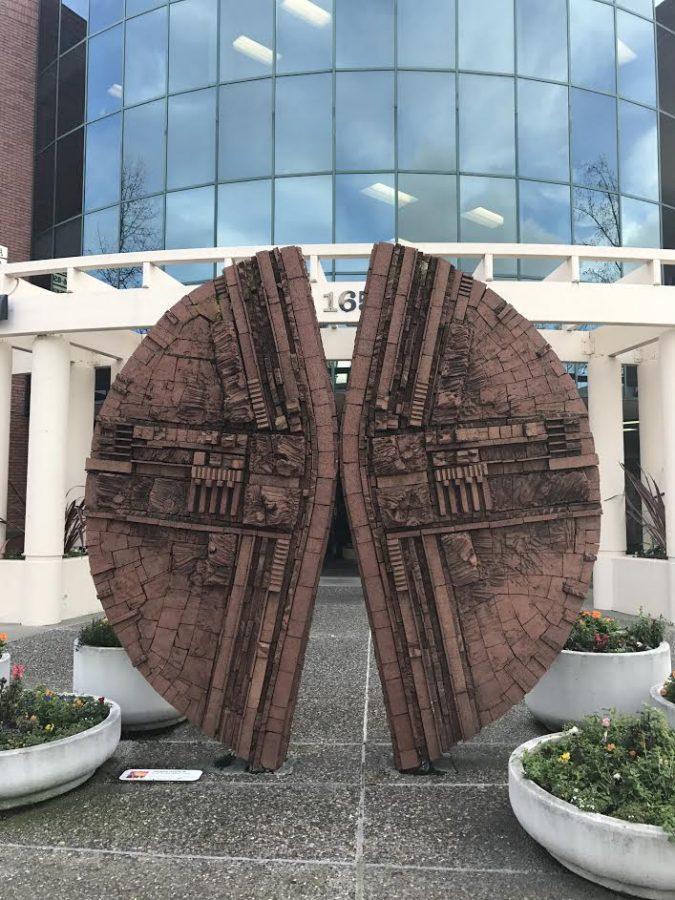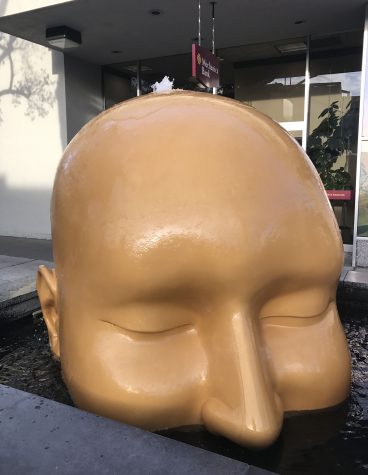Inside look at Walnut Creek’s historic art
March 17, 2017
Art is everywhere. For residents of Walnut Creek, some of the best art can be found right in our backyard. Most people have seen the iconic sculptures while shopping or eating out in the downtown area, but not many take the time to learn more about them.
To learn more about some of the interesting sculptures in our community, the Sentinel sought out Jane Emanuel, a member of the Walnut Creek arts commission which is in charge of implementing new pieces around the city.
Emanuel is also a tour guide for the outdoor art walking tours downtown. She sat down with us to explain the art selection process, the reason behind the necessity for art, and different signature pieces.
“Art does something for people when they look at art,” Emanuel explained on a drizzly Feb. 20 Monday morning, right next to the Lost in the Mail sculpture. “Artists of all kinds are the lead of society- they present ideas to us and we take part and observe it. It makes us think and see the world in different ways, and we all need that kind of stimulation. It does something for a person’s well being.”
So, why so much art in Walnut Creek? Emanuel was a wealth of information in responding to the Sentinel’s interest.
What facilitated the push for public art?
Actually, it goes back to John F. Kennedy in the 1960s- he was the first public president to push for the public art program around the country. Walnut Creek started with the program in the 1980s, but created and paid for it by the year 2000. Walnut Creek is one of the most active cities doing it- we have over 40 pieces in the central area. Ours is both a public and private development. When the city does a building, garage, hall, or makes renovations, they’re obligated to do a public art piece. When private developers come to build condos, they’re obligated to do something as well. The exact obligation is to develop an art piece that is equal to 1 percent of the construction cost. We start with an artist as early as we can, so that the artist can work with the architect of the building to determine things like if the sculpture will be fixed to the building or freestanding.
Why does a community want public art?
For starters, it creates a sense of pride in a community, it creates a sense of place, and it often reflects something about the city, like the history or the people. For example, down by the Cheesecake Factory is the site of the first elementary school of Walnut Creek. There are two sculptures of a boy and girl with a book in their hands, reminding everyone about where the city has come from. The sculptures show that they are hispanic, the flora and fauna that are indigenous to the area, and the grape leaves reflect the large grape growing area. Art can also be memorials, such as the Veterans Memorial. Art is used as a gathering spot, with benches to sit, to visit and congregate, such as the Fountain Head. And, of course, art is made for personal enjoyment.
What is the criteria for selecting the art?
Walnut Creek has an arts commission, and their job is to approve the art. A developer comes up with the artist, usually with an art consultant. They then come to the commission, and together, they pick appropriate spots on the project. The arts commission approves location, approves the artist, approves the art itself, In the process, the arts commission goes over lots of things, for example, if it is accessible to the public, if the materials will last, if it will be seen by pedestrians or drivers or public transportation, if it fits well with the building, et cetera.
How is the art paid for?
For a private project and art piece, the city uses a formula for the construction costs. If a private project doesn’t cost a lot, the art budget isn’t very high, or there’s no good spot, a developer can choose to put the money into the public art fund instead of into a private art piece. The art fund is used for many purposes- it’s used by the public art department to do a public piece, a temporary art exhibit, or other art activities. The money from a developer’s project, in addition to the cost of the building, the land, and the fees for environmental reports, developers often feel that that’s one more fee they must pay. Some developers used to fight it, but now, it doesn’t ever seem to stop a developer from building. So many developers want a signature piece on their property, and I think that is a wonderful affirmation of the public art program.
To check out the museum that is downtown Walnut Creek, public art walking tours go from April to November on the third Saturday of the month at 11am.

